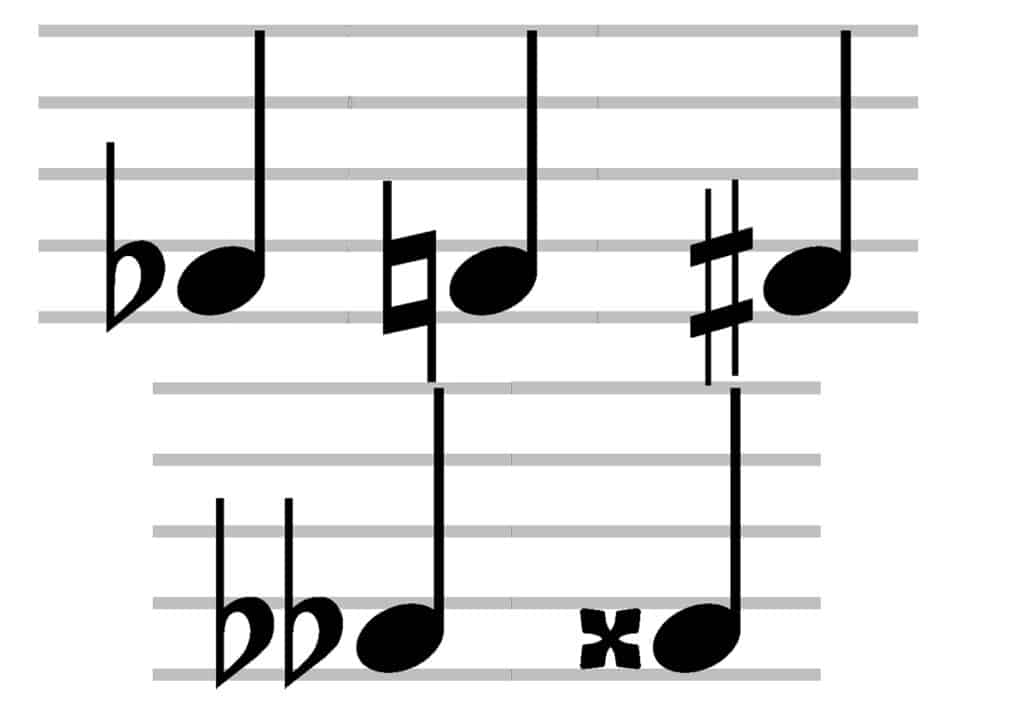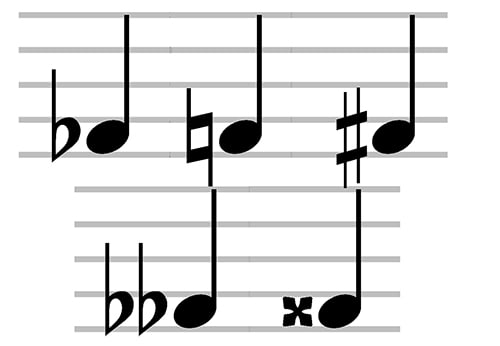The exploration of pitch alteration in Western music unveils a world of complex and expressive possibilities for composers and musicians. As a fundamental aspect of music theory, the understanding and application of sharps, flats, and other pitch alterations contribute to the richness of a musical piece, shaping its tonality, harmony, and emotional impact.
Western music consists of a total of 12 distinct notes, which include C, C#, D, D#, E, F, F#, G, G#, A, A#, and B. Out of these 12 notes, 7 are named C, D, E, F, G, A, and B. The remaining notes are recognized by modifying these names with a sharp (#) or a flat (b), which are also known as “accidentals” or “alterations” in musical terminology.
These alterations enable the creation of various scales and key signatures, which serve as the foundation for countless compositions across diverse genres and styles. From the earliest notations to the contemporary avant-garde, pitch alteration remains an essential tool in the art of music-making.
Need help remembering notes? Refer back to the lesson on What are Notes?

Sharps and Flats
In Western music, sharp and flat are terms used to describe the alteration of a pitch or note. They are symbols in musical notation that indicate raising or lowering a note by a half step or semitone.
Sharp (♯)
A sharp symbol raises the pitch of a note by a half step or semitone. For example, if you see a C♯ (C sharp) in a piece of music, it means that the C note should be raised by a half step to the next closest note, which is D.
Flat (♭)
A flat symbol lowers the pitch of a note by a half step or semitone. For example, if you see a B♭ (B flat) in a piece of music, it means that the B note should be lowered by a half step to the next closest note, which is A.
Sharps and flats are important in Western music because they allow for the creation of different scales and key signatures, which in turn help to create a sense of tonality and harmony in a piece of music. They are essential for expressing the full range of musical possibilities in composition and performance.
Naturals (♮)
A natural (♮) is a symbol used in musical notation to cancel a previous sharp or flat, indicating that a note should be played at its unaltered, or “natural,” pitch. Essentially, it restores a note to its original pitch within a diatonic scale.
For example, if a piece of music has an F♯ (F sharp) and later requires the musician to play the regular F note, a natural symbol would be placed before the F, like this: ♮F. This tells the performer to play the F note at its natural pitch, rather than the previously indicated F♯.
Naturals are important because they provide clarity in musical notation and help to avoid confusion when reading and interpreting a score. They are especially useful in passages where accidentals (sharps or flats) are frequently used or when a piece modulates (changes key) within a section.
Flats And Sharps In Key Signatures
key signatures are used to define the tonality of a piece, indicating which notes are sharp or flat throughout the composition. Key signatures consist of a series of sharps or flats placed at the beginning of the staff, after the clef, and before the time signature. They provide a convenient way for composers and performers to know which pitches to alter in a consistent manner without having to notate each accidental individually.
Key signatures are based on major and minor scales, which are built using specific patterns of whole and half steps. The pattern of sharps and flats in key signatures follows the Circle of Fifths, a sequence that shows the relationship between the 12 tones of the chromatic scale, their corresponding key signatures, and the associated major and minor keys.
Here’s a brief overview of key signatures with sharps and flats:
- Key signatures with sharps:
- G major/E minor: 1 sharp (F♯)
- D major/B minor: 2 sharps (F♯, C♯)
- A major/F♯ minor: 3 sharps (F♯, C♯, G♯)
- E major/C♯ minor: 4 sharps (F♯, C♯, G♯, D♯)
- B major/G♯ minor: 5 sharps (F♯, C♯, G♯, D♯, A♯)
- F♯ major/D♯ minor: 6 sharps (F♯, C♯, G♯, D♯, A♯, E♯)
- C♯ major/A♯ minor: 7 sharps (F♯, C♯, G♯, D♯, A♯, E♯, B♯)
- Key signatures with flats:
- F major/D minor: 1 flat (B♭)
- B♭ major/G minor: 2 flats (B♭, E♭)
- E♭ major/C minor: 3 flats (B♭, E♭, A♭)
- A♭ major/F minor: 4 flats (B♭, E♭, A♭, D♭)
- D♭ major/B♭ minor: 5 flats (B♭, E♭, A♭, D♭, G♭)
- G♭ major/E♭ minor: 6 flats (B♭, E♭, A♭, D♭, G♭, C♭)
- C♭ major/A♭ minor: 7 flats (B♭, E♭, A♭, D♭, G♭, C♭, F♭)
Depending on the key signature of a piece, the use of sharps or flats helps maintain the structure of the major or minor scale being used, ensuring that the music follows the specific tonality and retains its harmonic coherence.
Flats And Sharps In Written Music
In music notation, a sharp symbol “#” placed before a note indicates that the pitch of that note should be raised by one semitone. For example, if the note is F, placing a sharp symbol before it would indicate that the note should be played as F#.
Conversely, a flat symbol “b” placed before a note indicates that the pitch of that note should be lowered by one semitone. For example, if the note is A, placing a flat symbol before it would indicate that the note should be played as Ab.
Sharps and flats can also be used in key signatures to indicate the tonality of a piece of music. For example, a key signature with one sharp indicates the key of G major or E minor, while a key signature with two flats indicates the key of B-flat major or G minor.
It is important to note that sharps and flats do not change the duration of a note, but only its pitch.
Sharps and flats are both types of accidentals, which are symbols used to modify the pitch of a note. Accidentals can be either sharps (#), flats (b), or naturals (♮), which cancel the effect of a previous accidental or the key signature.

Less Common Note Alterations
besides sharps and flats, there are other terms and symbols used to describe the alteration of a pitch or note in Western music.
These pitch alterations are less common in traditional Western music but are used in various contexts, such as contemporary classical music, experimental music, or specific cultural musical traditions. They can provide composers with an expanded palette of pitches, allowing for more intricate and nuanced musical expression.
Some of these include:
Double sharp (𝄪)
A double sharp raises the pitch of a note by two half steps or semitones. It is notated with an “x” or a double sharp symbol (𝄪). For example, F𝄪 (F double sharp) is enharmonically equivalent to G natural.
Double sharps are typically used in two main contexts:
- To indicate a note that is already sharp in the key signature and needs to be raised by another semitone: In some musical keys, a note may be naturally raised by a semitone in the key signature (e.g., F# in the key of G Major). If a note in that key needs to be raised by another semitone, a double sharp is used to indicate this (e.g., F## would be two semitones higher than F#).
- To indicate a chromatic alteration to a note in a chromatic scale: In some chromatic scales or chromatic passages, double sharps are used to indicate a note that is already sharp in the key and needs to be raised by another semitone. For example, in a C# chromatic scale, the seventh note would be B# (which is one semitone higher than B natural), and if the music requires the note to be raised by another semitone, a double sharp would be used to indicate that the note is C natural.
Double flat (𝄫)
A double flat lowers the pitch of a note by two half steps or semitones. It is notated with two flat symbols (𝄫). For example, B𝄫 (B double flat) is enharmonically equivalent to A♭.
Microtones
Microtones are pitch alterations smaller than a half step or semitone. They are more commonly found in non-Western music, but can also appear in contemporary Western compositions. There are various systems for notating microtones, including the use of arrows or extended sharp and flat symbols.
Quarter tones
Quarter tones are a specific type of microtone that divides the interval between two adjacent notes in the chromatic scale into four equal parts, effectively creating a pitch halfway between a natural note and its sharp or flat alteration. Quarter tone notation typically uses symbols like half sharps (𝄪) and half flats (𝄫), or arrows pointing up or down.
For a whole list of alterations, check out this list of musical symbols.
Enharmonic Equivalents
An enharmonic equivalent refers to two or more pitches that have different names but are the same pitch in terms of sound and frequency. In other words, enharmonic equivalents are distinct notations for the same musical pitch. This concept is most commonly found in Western music, where sharps, flats, and other alterations are used to modify the pitch of notes.
For example, C♯ (C sharp) and D♭ (D flat) are enharmonic equivalents because they represent the same pitch, even though they are written and named differently. On a piano, both C♯ and D♭ are played using the same black key between C and D. Similarly, F♭ (F flat) and E are enharmonic equivalents, as well as G𝄪 (G double sharp) and A.
Enharmonic equivalents are important in music theory because they allow for flexibility in notation and can simplify the reading and understanding of a piece of music, especially when dealing with key changes, transpositions, or complex chord structures. They help maintain the integrity of the diatonic scale structure and facilitate clearer communication between composers and performers.
In some musical contexts, F flat may be used to indicate a note that is one semitone lower than F natural. However, since F natural is already one semitone higher than E, Fb is usually not used as a note name in music notation.
The choice of whether to use Fb or E will depend on the key signature and the context of the music being played. In most cases, it is more common and practical to use E instead of Fb.
The University of Puget Sound has practice exercises to review these concepts, found here.
Summary
Music notation uses symbols like sharps, flats, and naturals to alter the pitch of notes in a piece, while key signatures establish a framework for tonality based on a specific set of sharps or flats. Less common alterations such as double sharps, double flats, and microtonal adjustments further expand the range of available pitches.
Enharmonic equivalents highlight the concept of different note names representing the same pitch in a given tuning system, such as the 12-tone equal temperament used in Western music.
Understanding these elements is important for musicians and composers, as it allows them to navigate and manipulate the complex world of pitches and tonalities, ultimately leading to a richer and more diverse musical experience.
Go to next lesson: What are Whole Steps (Whole Tones) and Half Steps (Semitones)?
Go to previous lesson: What Is Timbre In Music?
Back to: Module 1

